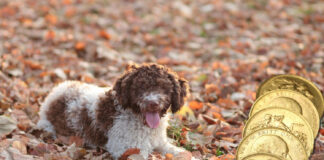From 16 July to 1 September 2021, the National Museum of Lithuania in Vilnius exhibited the hoard of the time of the Grand Duke Jogaila of Lithuania (1377–1392; 1386–1434 – King of Poland) which was found in spring of this year in Raišiai, which is in the vicinity of Vilnius, and handed over to the museum. The hoard includes 62 items dating back to the end of the 14th century, the main and most valuable of which are 58 silver coins and two silver ingots. The coins were found scattered in the ground due to various earthworks which were carried out on the site in the 20th century. The first few items were discovered by metal-detector enthusiast, then an area of 234 sq. m was investigated during archaeological excavations and an area of 5,370 sq. m was thoroughly surveyed. In addition to numismatics, a number of fragments of household ceramics, fragments of clay plaster, two iron knives, and several other small lost or discarded artifacts dating back to the same period suggest the existence of a homestead or settlement which stood near this place at the end of the 14th century.
The Hoard: Pennies, Groschen, Silver Bars
Among the coins are two Prague groschens, minted during the reign of John I of Luxembourg (1310–1346), six – during the reign of Charles I (IV) (1346–1378), nine – during the reign of Wenceslas IV (1378–1419), and one counterfeit Prague groschen which was minted during the reign of an unidentified ruler. Of the pennies of the Grand Duchy of Lithuania – 40 were minted during the reign of Jogaila (1377–1392) and almost all coins were minted around 1388–1390 (obverse – Knight, reverse – Double Cross on a Shield). The three coins are considered to be minted at an earlier point in time – with a portrait (which most likely is the Blessed Virgin Mary) and Latin inscription, dating from about 1386 to 1387, and two coins with an illegible legend and a Lion with the Knot (plaiting) symbol, which were probably minted around 1377 to 1386, when Jogaila had not yet been elected as the King of Poland. The latter coins are causing a lot of debates among numismatists as it is believed that they could have been minted by the Grand Duke Vytautas of Lithuania (1392–1430). In addition to coins, the hoard contains two triangular section silver bars of half-rouble of the Grand Duchy of Lithuania dating back to the 4th quarter of the 14th century, a fragment of a triangular section silver bar and a 14th century silver ring with a braided front. The concealment of the hoard may be related to the siege on Vilnius castles which took place in the summer of 1390.
Until now, only over ten hoards from this period were known to be found in Lithuania, almost all of them were dispersed, and a large part of the finds ended up in private collections. It can be assumed that the hoard of Raišiai, which survived to this day, is incomplete. Nevertheless, it is one of the biggest and most interesting hoards of the end of the 14th century found in Lithuania. This treasure presented surprises that had not been recorded among Lithuanian finds up to this point, namely – the Prague groschens of John I of Luxembourg, as well as Prague groschens which were clipped, i.e. adapted to the local monetary system; this was also the first time that Grand Duchy of Lithuania coins with a Lion and an inscription were found in a hoard.
The complexes of coins dating back to the second half of the 14th century are of particular value to science. This is the period when the Grand Duchy of Lithuania started minting coins, and there are no written sources that would allow them to be attributed to a specific ruler. Laconic nature of the coins from the early period also makes research difficult: no dates are on the coins and only on some of them the names of the rulers or their fragments are eligible. In the second half of the 14th century, at least ten different types of coins were minted in the Grand Duchy of Lithuania, some of which are extremely rare. Thus, any new complex provides valuable knowledge about the beginning of the Grand Duchies money history.
The hoard will remain at the National Museum and a thorough publication of it is in preparation.
Here you can visit the website of the National Museum of Lithuania.
Dalia Grimalauskaitė is curator at the National Museum of Lithuania and was one of the editors of the monograph “Money in Lithuania”.
Read more news concerning hoards and treasures.






